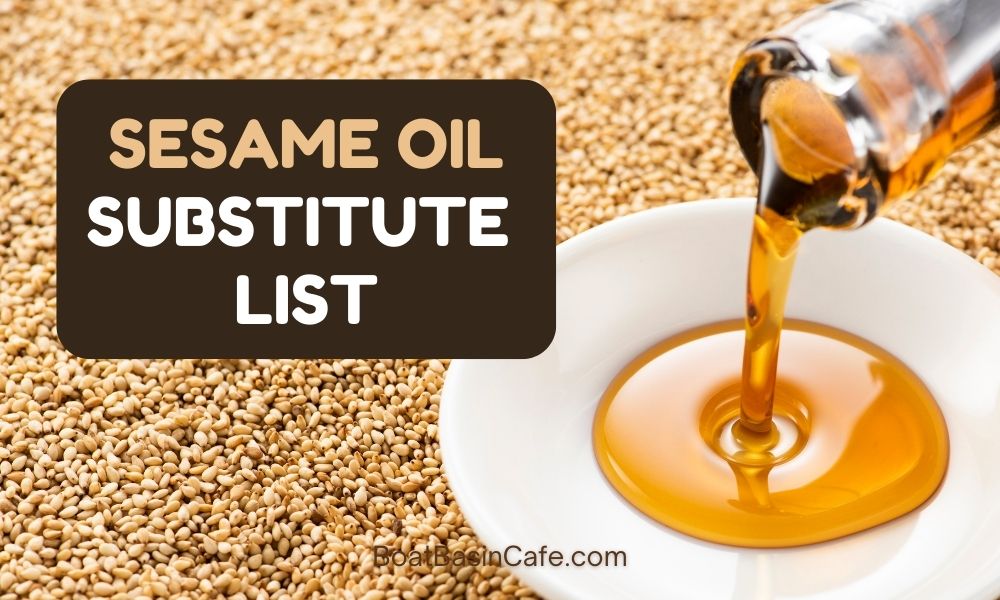Find the perfect substitute for sesame oil so that you can enjoy the great taste of any cuisine without sacrificing quality, flavor, and nutritional value.

Sesame oil is a common ingredient in Asian cuisines, but it can be difficult to find a substitute that will give the same flavor. However, there are a few options that can be used as a substitute for sesame oil. For example, peanut oil or vegetable oil can be used as a 1:1 replacement in most recipes.
But if you’re looking for a more flavorful sesame oil substitute, try toasted sesame oil. It has a more intense flavor than regular sesame oil – which gives a rich and nutty flavor to my stir fry recipes – and can be used as a 1:1 substitution. Let’s find out what’s the best sesame oil replacement.
About Sesame Oil

The Sesamum indicum plant is an annual or short-lived perennial with a pungent odor. It has white, tubular, bell-shaped flowers that are frequently spotted and pink-tinged, as well as small, sausage-shaped pods filled with numerous tiny pear-shaped sesame seeds that can be white, yellow, brown, or black.
Sesame, which comes originally from Africa, has been widely naturalized and grown as a crop all over the world. It was first grown in India and the Near East thousands of years ago. Sesame oil is obtained by pressing the sesame seeds.
In traditional Asian cooking, sesame oil plays a significant role. As a cooking oil, it has a pleasant flavor, is free of unpleasant aromas, is quite stable, and resists going rancid. Sesame oil has a high concentration of polyunsaturated fatty acids, is nutrient-dense, and is naturally anti-inflammatory according to the American Botanical Council.
Sesame oil has a flavor that is intensely nutty and toasted, making it stand out from other oils and condiments. The color is between white and yellow when it isn’t roasted. Its smoke point is 410°F (210°C).
Toasted Sesame Oil Vs Untoasted Sesame Oil
Raw, ground sesame seeds produce the standard untoasted sesame oil. It can be used for roasting, frying, and even as seasoning. Its hue ranges from light to golden yellow. In essence, you can use this normal version in the same way as you would any other cooking oil, like canola oil.
On the other hand, the toasted version is prepared solely from milled sesame seeds that have been roasted. Its flavor is more complex and its color is deep amber to brown. The flavor is deeper and more intensely nuttier than the ordinary variety. However, because it has already been toasted, it has a lower smoke point and is therefore excellent for seasoning or completing recipes.
Types Of Sesame Oil
| Types Of Sesame Oil | Characteristics | Good For |
| Light | Light color, mild and neutral flavor with a smoke point of 410°F | High-heat searing, sauteing, frying |
| Dark | Dark color with a smoke point of 450°F | Cooking over medium to low flame |
| Unrefined | Organic or extra virgin oil with a smoke point of 350°F and used for both cooking and applying on the skin and hair | Sauteing and sauces |
| Black | Creamy texture, deep flavor | Cooking and salad dressings |
There are four types of sesame oil – light, dark, unrefined, and black. Let’s look at each of these in turn for a better understanding.
- Light Sesame Oil
This is usually what we see labeled as simply “sesame oil”. As it’s made with untoasted seeds, its flavor is mild and it has a light color. It can be treated the same way as any regular cooking oil like canola oil. The neutral flavor of light sesame oil is perfect for daily cooking and frying. With its high smoke point at 410°F (210°C), you can use it for searing, sauteing, and frying on high heat.
- Dark Sesame Oil
You can find dark sesame oil labeled as either “sesame seed oil” or “sesame oil”. It’s made from seeds that have been toasted and that’s why it has a color range varying from gold to brown to amber. Dark sesame oil has a higher smoke point at 450°F (232°C) but it’s better not to fry or cook anything in this oil for a long time as the flavor tends to disappear.
- Unrefined Sesame Oil
Unrefined sesame oil is something that you won’t find in regular grocery stores. This unrefined sesame oil is also known by other names – cold-pressed, extra virgin, virgin, or organic sesame oil – and is made from untoasted sesame seeds. With a medium smoke point of 350°F (177°C), it’s good for sauteing and making sauces and is also applied to hair and skin.
- Black Sesame Oil
Black sesame oil contains just black sesame seeds. It has a creamy texture and a deep, nutty flavor. For use in cooking, black sesame oil can be purchased as toasted oil under the Lee Kum Kee brand. The cold-pressed variety adds a ton of flavor, serves a wide range of botanical functions, and tastes great in salad dressings.
Difference Between Sesame Oil And Sesame Seed Oil
Sesame seeds are used to make both sesame oil and sesame seed oil and the two types are occasionally labeled interchangeably. In general, “sesame oil” refers to light sesame oil while the darker variety that is sold in smaller bottles at the market is referred to as “sesame seed oil.”
Substitute For Sesame Oil: Buying Guide For The Best Results
The sesame seed oil substitute list can be long and before I get into that, let me first tell you what you should look for before you choose an alternative to sesame oil so that you can get as close as possible to the original sesame oil flavor.
Smoke Point
The temperature at which an oil will begin to smoke and break down is known as the smoke point. Cooking oil can lose part of its nutritional content and alter the flavor of food when it starts to smoke. That’s why it’s essential to decide on the purpose for which you are going to use a sesame oil substitute.
For cooking in high temperatures – for example, French fries – you need to use an oil with a high smoke point, similar to sesame oil. If you’re slow cooking like making sirloin steak in a Crockpot, you can opt for any oil with a lower smoke point like unrefined canola oil or extra virgin olive oil. And if you want to use oil in salad dressings, it’s best to choose a sesame oil substitute that has a low smoke point like walnut oil.
However, some oils with a moderate or high smoke point are versatile and can be used for cooking and salad dressings – for example, avocado oil, sesame, olive, and grapeseed oil.
Flavor
The kind of flavor note you want to achieve will also help you determine which oil to use instead of sesame oil. You will find stronger flavor in oils pressed from seeds of nuts and fruits like sesame, mustard, and others whereas vegetable oil won’t have a strong flavor. So, if you’re cooking certain Indian dishes, mustard oil would be the best choice. But if you want the flavor of the ingredients to stand out, you should use light sesame oil or substitutes for vegetable oil.
Health Benefits
When choosing a sesame oil alternative, besides flavor, taste, and smoke point, you should also consider the nutritional content of the oil. Some oils are good for our heart, brain, and other body parts. But you need to keep in mind that oils also pack in a lot of calories.
You should choose a sesame oil substitute that has polyunsaturated and monounsaturated fats like olive oil and vegetable oils. If you see that the oil you want to choose has a high amount of saturated fats, it’s not going to be beneficial for your health, especially your cardiac health.
According to MedlinePlus, both monounsaturated and polyunsaturated fats can help reduce your bad cholesterol levels. Polyunsaturated fats are also a source of omega-3 and mega-6 fatty acids that are vital for cell growth and brain function.
| Pros | Cons | Best Used For | Smoke Point | |
| Olive Oil | Versatility Neutral flavor Health benefits | Lacks nutty flavor Hig in calories | Deep frying, regular cooking, baking, salads | 390-470°F (200-243°C) |
| Canola Oil | Neutral flavor Health benefits Widely available | Lacks umami flavor | Shallow and deep frying, baking | 400°F (204°C) |
| Peanut Oil | Nutty flavor Nutritional value | Not for all types of cooking due to dominant nutty flavor | Sauteing, frying, deep-frying, wok-frying | 440°F (227°C) |
| Tahini | Closest flavor match Rich in nutrients | Lacks the same consistency Not recommended for frying and cooking | Sauce, salad dressings, dips | N/A |
| Flaxseed Oil | Nutty flavor Rich in Omega-3 fatty acids and other nutrients | Limited use in cooking Low smoke point | Salads, dips, sauces | 225°F(107°C) |
| Grapeseed Oil | Versatility Neutral flavor Health benefits | Short shelf life High in calories Lacks the nutty flavor | Sauteing, frying, deep-frying, wok-frying, baking | 420°F (215°C) |
| Perilla Oil | A nutty, earthy flavor Nutritional value Similar consistency | High in calories Not easily available | Salads, dressings, over stir-fries, sauteing | 327°F (164°C) |
| Avocado Oil | Neutral flavor Heart-healthy Buttery, creamy texture | High in calories Not suitable for deep frying | Sauteing, baking, pan-searing, frying | 520°F(271°C) |
| Coconut Oil | Good health benefits Mild, nutty flavor | Not suitable for high-heat cooking and frying High in saturated fats | Baking and medium- to low-flame cooking | Unrefined 350°F(177°C) Refined 400°F(204°C) |
| Walnut Oil | Health benefits Nutty flavor | Cannot be used for high-heat cooking Expensive | Salads, marinades | 225°F(107°C) |
| DIY Sesame Oil | Easy to make | Will not have the same health benefits as sesame oil | Cooking | N/A |
| Toasted Sesame Seeds | Same nutty flavor Multiple health benefits Low-cost No hassle | Can’t work as a binder | As dry sprinkles on salads and dishes | N/A |
01 Olive Oil
Olive oil is the best substitute for sesame oil in stir fry, regular cooking, and salads. Did you know that you can use olive oil for baking brownies too? No kidding! Use extra virgin olive oil to match the flavor as close as possible to sesame oil as regular olive oil won’t give you the same nutty flavor as sesame oil. The consistency is also similar, making it a top choice as a sesame oil substitute. Health benefits match as well as both oils contain polyunsaturated fats. Olive oil is best for making stir-fry recipes, marinating, roasting, dipping your bread into it, or drizzling over your salad. Refined olive oil has smoke points between 390°F and 470°F (200°C and 243°C). Use in equal amounts or 1:1 ratio to get the best flavor. Another plus point is that olive oil is widely available and you can get it easily from any store. Just a bit of a downside is the calories packed in olive oil. A tablespoon or 13.5 grams of olive oil contains 119 calories.
02 Canola Oil
To replace light sesame oil, you can use canola oil, a type of vegetable oil consisting of different kinds of rapeseed. Canola oil is a common kitchen ingredient as it’s more affordable than other oils and its main advantage is that it has the lowest amount of saturated fats. Plus, it has omega-3 and omega-6 fatty acids, making it healthy to consume. As it has a neutral flavor and a high smoke point of 400°F (204°C), you can use it for both shallow- and deep-frying, baking, and cooking. However, it cannot serve as a dark sesame oil substitute as it lacks the umami flavor.
03 Peanut Oil
Made from peanuts, peanut oil or groundnut oil is a great sesame oil substitute as it has all that nutty flavor although not as intense as it is in sesame oil. With a high smoke point of 440°F (227°C), it’s great for wok frying Asian staple recipes like noodles. Unrefined peanut oil works great as a toasted sesame oil alternative with its more subtle flavor.
Besides the rich flavor of regular peanut oil, it is healthy as it contains compounds that prevent the absorption of cholesterol, thereby keeping your heart healthy. With monounsaturated and polyunsaturated fats, peanut oil has multiple health benefits. You can use peanut oil as a substitute for sesame oil in dishes that need sauteing, deep-frying, and stir-frying. However, many people are allergic to peanuts so you can always choose one of the 10 best oils you can use as peanut oil substitutes.
04 Tahini
Tahini paste is made from lightly roasted sesame seeds so use it as a toasted sesame oil substitute to get the same flavor. You’ll find the same nutty and toasted tones but tahini is an oily paste, not an oil, so your dish won’t have the same consistency. Another downside is that if you’re allergic to sesame oil, then you can’t use tahini as a sesame oil substitute. Moreover, if you’re calorie conscious, then you should know that it’s a bit on the higher side as a tablespoon of tahini has 89 calories. Since you can’t use it instead of light sesame oil in your cooking, you need to mix it with a base oil like sunflower oil, and this further increases the calorie count. Rich in certain vitamins and anti-oxidants, tahini is good for your health. Use tahini paste as a dip or add some to your salad for a richer taste and creamy texture.
05 Flaxseed Oil
Flaxseed oil has a similar nutty flavor profile and works perfectly as one of the sesame oil substitutes. However, with a low smoke point of 225°F(107°C), you can’t really cook in flaxseed oil. Moreover, it can change the whole flavor of a cooked dish so instead, use it in salads, dips, and sauces to get a warm, nutty flavor.
Only certain dishes that demand the use of flaxseed oil will justify its use. Full of omega-3 fatty acids and other nutrients, flaxseed oil can be added to smoothies and shakes for a healthy dose. It’s especially good for vegans who can obtain their required amount of Omega-3 fatty acids from flaxseed oil as they don’t eat meat or fish, the primary source of Omega-3 fatty acids in our diet.
06 Grapeseed Oil
Grapeseed oil is a great oil to use as a substitute for light sesame oil because it has a subtle flavor and a high smoke point at 420°F (215°C), making it a good choice for cooking. It has a neutral flavor and you can use it with any ingredients as it won’t overpower the dish. However, don’t expect the nuttiness of sesame oil in grapeseed oil. You can cook, sauté, bake, stir fry, deep fry, and wok fry, using this as one of the sesame oil substitutes. Besides cooking, you can apply grapeseed oil on the skin as it contains Vitamin E, a great antioxidant that protects our skin. There are a couple of downsides to grapeseed oil though. It is high in calories – a tablespoon contains 120 calories. Plus, it has a very short shelf life, confirming your doubts about does oil go bad.
07 Perilla Oil
As a toasted sesame oil alternative, you can try perilla oil. It’s made by pressing perilla seeds from their plants which are widely grown in Asia. Best known for its nutty and earthy flavor with a hint of licorice and anise, perilla oil is a popular seasoning in Korean cuisine.
It works well as a sesame oil substitute in salads, salad dressings, and if drizzled over stir-fries for its similar bold and nutty taste and consistency. Perilla oil is not commonly found in grocery stores but you can order it online or find it in specialty stores.
With 50% more fatty acids found in perilla oil than in regular cooking oils, it offers a wide range of health benefits – it has a high level of omega-3 fats that are good for our brain and heart health. Moreover, perilla oil has been shown to have anti-inflammatory properties and improve allergies and airflow to relieve asthma. It should be used by pregnant women only after a doctor consultation. High in calories, a tablespoon of perilla oil has 120 calories and is, therefore, not for those who are trying to lose weight.
At a smoke point of 327°F (164°C), perilla oil is not suitable for high-flame cooking and is best used as a flavor enhancer in salads, and dressings and can also be used for sauteing.
08 Avocado Oil
As the name suggests, avocado oil is extracted from the flesh of the fruit and has a neutral flavor profile. Therefore, you can’t match the flavor of toasted sesame oil with avocado oil but it shares a similar consistency and you won’t be disappointed with the texture. In terms of flavor, it doesn’t pack in much umami but gives a butter, creamy texture to your dish. At a high smoke point of 520°F(271°C), avocado oil can be used in high-heat cooking, stir-frying, sauteing, baking, dressings, and marinades.
Rich in monounsaturated fats, omega-9 fatty acids, and essential vitamins, avocado oil is considered a heart-healthy oil. However, it’s a bit on the higher side with its calorie count – 124 calories in a tablespoon. Avocado oil is not recommended for deep frying although it’s perfect for sauteing, broiling, pan-searing, and even baking. It adds a dose of freshness when added to salads.
09 Coconut Oil
Coconut oil is not only great for your hair and skin but is also a perfect cooking oil that can easily replace sesame oil. Although it shares a nutty flavor profile with sesame oil, it’s not quite the same as it has a mild flavor and won’t work if you’re looking for a toasted sesame oil substitute. If you like coconut flavor, then you won’t mind having a distinct aroma in your dish.
Although it’s good for your health as it can prevent infections and have other benefits for your health, you should use it in low doses as it has a high content of saturated fats that can raise your cholesterol level. Unrefined coconut oil has a low smoke point of 350°F(177°C) while its refined counterpart will start to break down at 400°F(204°C). So, you should not do any frying or high-heat cooking with unrefined coconut oil. Opt for the refined one instead. A plus point is that you can easily get coconut oil for cooking in any store. However, check if coconut oil goes bad before using it.
10 Walnut Oil
Walnuts are naturally rich in antioxidants and healthy fats and so is the walnut oil made from this superfood. Walnut oil is healthy for the gut and its nutty flavor works well as a sesame oil alternative if you use it in salads and fried. As it can quickly lose its flavor and turn bitter due to a low smoke point of 225°F(107°C), it’s best not to use walnut oil for cooking. Use it in marinades and salads or as a finishing touch to dishes for a nice nutty flavor. There are two types of walnut oil – cold-pressed and expeller-pressed. If you don’t want to splurge on walnut oil, choose the expeller-pressed one.
11 Sunflower Oil
Sunflower oil is a more affordable alternative to light sesame oil that has no discernible flavor. It can be used for any type of cooking, including high-heat cooking (like deep frying). It also works in salads with its neutral flavor. Packed with fatty acids, polyunsaturated and monounsaturated fats with little to no saturated fats, sunflower oil is great for your health. Its high smoke point of over 449.6°F(232°C) makes it a versatile oil that you can use for cooking and frying. However, you can’t replace toasted sesame oil with sunflower oil as the flavor profile will not be similar at all.
12 DIY Sesame Oil
Well, nothing’s stopping you from making your very own DIY sesame oil! All you need is a cup of oil with a neutral flavor like vegetable or canola or sunflower oil and ¼ cup of sesame seeds. Take a heavy-bottomed wok and heat up the ingredients over medium heat for 2 minutes without overheating them. Once it’s completely cooled down, blitz it in one of those blenders used as a food processor. Simply strain the liquid and store it in a clean glass bottle. It’s the easiest way to get sesame oil!
13 Toasted Sesame Seeds
Toasted sesame seeds are a great sub for sesame oil if you’re looking for the same nutty and bold flavor. However, it won’t have the oily consistency obviously, and won’t work as a binder in sauces and salads if that’s what you intended to use it as. It’s best used as a dry sprinkle over salads and dishes like sesame chicken. With multiple health benefits, you can use this sesame seed substitute easily. Toasted sesame seeds are low-cost and take no effort.
FAQS
What Are The Substitutes For Toasted Sesame Oil?
Perilla oil is one of the best substitutes for toasted sesame oil due to its strong nutty flavor. Other oils like avocado oil, walnut oil, peanut oil also carry the same nutty taste.
If you are looking for a substitute to use in your daily cooking, olive oil and sunflower oil are the best alternatives out there. Toasted sesame oil has a very bold, nutty flavor that can enhance any dish.
If you like that toasty, nutty fragrance then you should pick one of our recommended nut oils. But if you just want an alternative for daily cooking, we would suggest going for olive oil. You can use tahini as your salad dressing instead of sesame oil.
What Are The Substitutes For Sesame Oil In A Stir-Fry?
Stir-frying is one of the most common techniques used in Chinese cooking. The core of making a good stir fry is to pick an oil that has a very high cooking temperature.
Since stir-frying involves high heat, if you pick a cooking oil that has a low smoke point, the oil will burn and your dish will be ruined. The best alternative of sesame oil for stir-fry is peanut oil.
Peanut oil has a smoking point of 440F which is much higher than any regular cooking oils. Other substitutes are canola oil and sunflower oil. Canola oil is a healthy option if you are on a strict diet.
What Are The Substitutes For Sesame Oil In Fried Rice?
Sesame oil is used in fried rice because it enhances the flavor of other ingredients. You can basically use any neutral oil for fried rice. Canola oil is used by the majority for fried rice all around the globe.
Can You Substitute Olive Oil For Sesame Oil?
In place of sesame oil, you can substitute olive oil in an equal amount for cooking, marinades, and sauces like teriyaki.
Can You Substitute Sesame Oil For Vegetable Oil?
If you try to substitute sesame or toasted sesame oil for vegetable oil, the flavor profile of your dish may vary due to the strong flavor of sesame oil.
Can You Substitute Sesame Oil For Peanut Oil?
Yes, you can as both share a nutty flavor.
Can I Use Sesame Oil Instead Of Olive Oil?
You can but olive oil has a mild flavor and your dish won’t have the same rich flavor of sesame oil.
Health Disclaimer: The health benefits described for each substitute are generalized. They may not apply to everyone. Consult your doctor or a registered dietitian for dietary advice tailored to your specific needs.






